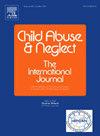儿童易怒-攻击特征与亲子暴力:预测青少年暴力的互动效应证据。
IF 3.4
2区 心理学
Q1 FAMILY STUDIES
引用次数: 0
摘要
目的:早期易怒、攻击和亲子暴力(PCV)被认为是预测以后的暴力行为。然而,很少有研究同时考察了这些因素。本研究旨在探讨易怒和攻击在儿童期如何共同表现,以及这些表现、PCV及其相互作用是否与青少年晚期暴力有关。方法:前瞻性样本900名参与者(55.8%女孩;55.7%的黑人,24.7%的白人,11.9%的混血儿,7.7%的其他种族)来自儿童虐待和忽视纵向研究(LONGSCAN),从4岁到18岁。照顾者每两年评估一次儿童的易怒和攻击性(4-12岁),并在12岁之前自我报告对孩子的暴力行为。儿童在18岁时报告了他们的暴力行为。结果:基于群体的双轨迹模型确定了三种不同性别的易怒和攻击综合水平的特征:易怒和攻击特征、仅易怒特征和典型发展特征。二项逻辑回归分析显示,易怒和攻击性特征与男孩的暴力行为有独立的联系。PCV仅在易激惹型男孩中与暴力有关。在女孩中没有发现这种联系。结论:在儿童期,攻击性与易怒同时表现并持续存在,而非相反。同时伴有攻击性和易怒的男孩有增加的暴力风险,而且易怒的男孩只有在暴露于PCV时才会这样做。这些发现表明,易怒和攻击性在预示暴力反社会行为方面具有性别差异,并表明需要将这些问题与暴力育儿结合起来解决,以防止青少年暴力。本文章由计算机程序翻译,如有差异,请以英文原文为准。
Childhood irritability-aggression profiles and parent-to-child violence: Evidence of interactive effect in predicting youth violence
Objective
Early irritability, aggression, and parent-to-child violence (PCV) each are presumed to predict later violent behavior. Few studies, however, have examined these factors simultaneously. This study investigated how irritability and aggression jointly manifested during childhood and whether such manifestations, PCV, and their interactions were associated with late-adolescent violence.
Method
A prospective sample of 900 participants (55.8 % girls; 55.7 % Black, 24.7 % White, 11.9 % mixed race, 7.7 % other race) from the LONGitudinal Studies of Child Abuse and Neglect (LONGSCAN) was followed from 4 to 18 years old. Caregivers assessed children's irritability and aggression biyearly (ages 4–12), and self-reported violence toward their children by age 12. Children reported their violent behaviors at age 18.
Results
Group-based dual trajectory modeling identified three profiles varying in the combined levels of irritability and aggression for both genders: Irritable and Aggressive profile, Irritable Only profile, and Typically Developing profile. Binomial logistic regression analyses showed an independent association of the Irritable and Aggressive profile with violence in boys. PCV was associated with violence only in boys with the Irritable Only profile. No such associations were found in girls.
Conclusions
Aggression manifested and persisted alongside irritability, but not vice versa during childhood. Comorbidly aggressive and irritable boys had an increased risk of violence, and irritable boys did so only when exposed to PCV. These findings suggest the gender-specific roles of irritability and aggression in portending violent antisociality, and indicate the need to address these problems in conjunction with violent parenting for preventing youth violence.
求助全文
通过发布文献求助,成功后即可免费获取论文全文。
去求助
来源期刊

Child Abuse & Neglect
Multiple-
CiteScore
7.40
自引率
10.40%
发文量
397
期刊介绍:
Official Publication of the International Society for Prevention of Child Abuse and Neglect. Child Abuse & Neglect The International Journal, provides an international, multidisciplinary forum on all aspects of child abuse and neglect, with special emphasis on prevention and treatment; the scope extends further to all those aspects of life which either favor or hinder child development. While contributions will primarily be from the fields of psychology, psychiatry, social work, medicine, nursing, law enforcement, legislature, education, and anthropology, the Journal encourages the concerned lay individual and child-oriented advocate organizations to contribute.
 求助内容:
求助内容: 应助结果提醒方式:
应助结果提醒方式:


